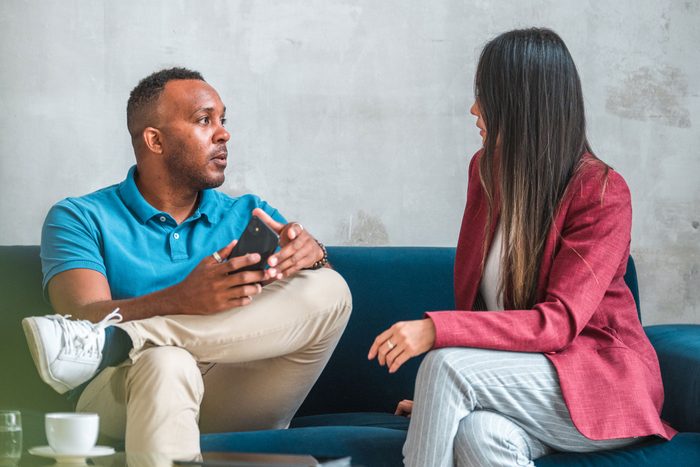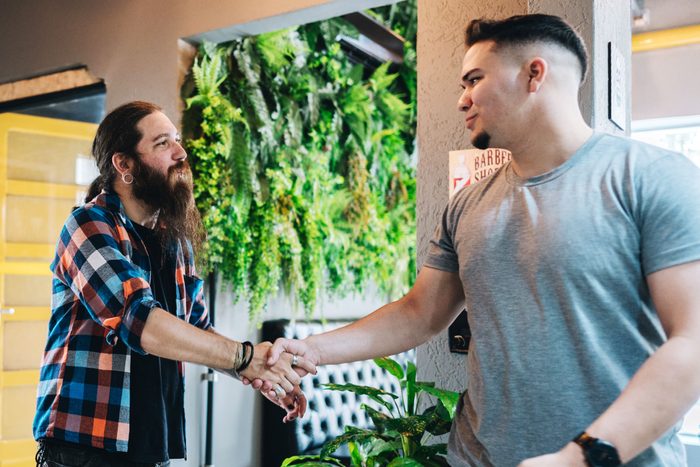
The dreaded awkward silence
You know that feeling when you’re at party and suddenly fall off a conversational cliff? You’ve asked a new acquaintance what they do, where they’re from and how they know the host … and then an awkward silence starts to creep in. Maybe you should excuse yourself, pretending you need another drink or have to visit the restroom. Or do you hang in there and try to get things back on track?
As a therapist who has worked with people to tackle relationship challenges for more than a decade, I spend a lot of time helping my clients overcome their fears of awkward silence and social anxiety. They want to learn how to make friends as an adult, navigate work events more seamlessly or simply have more natural conversations with acquaintances, but they aren’t quite sure how to do that—especially in the moment, when a few seconds of awkward silence can feel like an eternity.
The good news is that with a little preparation and practice, you can learn to talk to anyone. When you go beyond small talk and start to make a deeper connection, there will naturally be fewer gaps in your conversation. Ahead, I’ll give you tips on how to make conversations less awkward, as well as how to jump-start a flatlining conversation—easily.
Get Reader’s Digest’s Read Up newsletter for more relationship tips, humor, cleaning, travel, tech and fun facts all week long.

Ask open-ended questions
This is one of the best tactics to make conversations less awkward. Yes-or-no questions can keep a conversation from settling into a good flow—or end it before it really starts. After all, the other person can just say “yes” or “no” … and then nothing else. Better conversation starters employ open-ended questions, like “What are you excited about these days?” or “What’s something I don’t know about you?” (rather than “Did you have a nice weekend?”), and invite answers that are longer than one or two words.
If your conversation partner seems to have trouble asking these types of questions, make sure to answer whatever they’re asking with more than a word or two. Then bounce back with your own open-ended question, like a game of tennis. When you lead by example, chances are the other person will get the hang of it and feel less awkward. Remember: Every question is an opportunity to connect, so don’t waste it!
Share about yourself
While it’s important to be curious about other people, only asking them questions instead of also sharing about yourself is an etiquette mistake, and it can make you appear cold or distant. People don’t want to feel like they’re being interrogated, and friendships are built on mutual sharing. So don’t be afraid to talk about your life and discuss what’s been exciting or challenging for you lately.
My therapy clients often tell me they worry that new acquaintances will find them uninteresting and annoying, which is why they withhold this sort of information. But excitement is contagious and can create positive feelings in a conversation. One trick could be to imagine you’re catching up with a very close friend. What would you be telling them about? Maybe it’s that presentation you bombed at work, or the television show you’re bingeing, or the hilarious thing your child said about you to their teacher. If you don’t think it’s too personal (for example, what you’re working on in therapy might be too much for a new relationship), use it in a conversation with a new friend or acquaintance.
Bring up a previous topic
Sometimes, second or third conversations can feel more awkward than that initial one. When you’ve already asked those introductory questions, like where someone is from or what they do for a living, the awkward silence can creep in the next time you chat. To ward that off, try following up on things they mentioned in a previous conversation. You could say, “Tell me more about living in Texas,” or “What’s a typical day like for you as a nurse?” This will show the other person that you paid attention to what they said in your initial conversation and are invested in hearing more about their life.
If you’ve forgotten something they mentioned and need to ask again, simply apologize and ask. No one expects you to remember everything.

Pay attention to your own body language
When you’re talking to someone, make sure that your body language communicates friendliness. If your arms are crossed or you aren’t making eye contact, this sends the signal that you aren’t very interested in hearing what the other person has to say. While that may seem obvious, it’s easy to fall into bad habits like this, especially when you’re nervous. And here are a few more body-language mistakes you may not know: Don’t shove your hands into your pockets or close them into fists; instead, keep your hands visible and open. And try not to tap your fingers excessively or touch your face too much, as this can indicate you are bored or nervous.
That said, don’t overdo it with the “attentive” body language either. Excessive eye contact, head nodding or frequent, forced smiles are likely to make things more awkward. How do you know when you’re laying it on too thick? If someone begins looking away awkwardly, crossing their arms or legs defensively, or losing their train of thought, it could be a sign that you’ve gone overboard and you’re making them uncomfortable. Take a deep breath, and take it down a notch. For the rest of the conversation, try to relax, and be present and open.
Engage in a little small talk
When people are thinking about how to make conversations less awkward, they often assume that they should cut the small talk. But small talk is an essential part of building a connection with someone. Unlike other primates, who groom each other’s fur to build connections, humans use language to create social bonds. A simple question like “How have you been?” or “How was your weekend?” can be the start of a good conversation. Rephrasing them into fuller questions like “What’s the best thing that happened do you this weekend?” or “What’s life throwing at you these days?” can be the start of an even better conversation.
Be patient if people use small talk, and if you find yourself getting bored, try to answer questions like “How are you?” a little more authentically, rather than just saying, “Fine,” or “Good.” This will help the conversation settle into a good flow.
Talk about something meaningful
While small talk can break the ice and also fill in the gaps of an awkward silence, things can get awkward again soon without anything meaty to talk about. We tend to underestimate how much other people actually are interested in hearing about what’s going on in our lives. It’s true that not everyone is going to share your passion for banjo music, but that doesn’t mean they won’t enjoy watching you get excited about it. Life would be boring if we all had the same interests, and you never know when the details of your own life will seem novel to another.
If you’re unsure where to start, try thinking of one of these three ideas: something interesting you’ve learned recently, something you’ve found challenging in your life lately, and something you’ve been working hard on or really care about. These are great starting points for deeper conversations. One caveat: In casual, initial conversations, try to avoid hot-button topics like religious and political beliefs. Let the other person get to know you a little first, and vice versa.

Don’t look at your phone
A recent survey found that Americans check their phones 144 times per day on average. Resist the urge when you’re speaking to someone else! Looking at your phone, even briefly, can interrupt the flow of conversation and indicate to the other person that you don’t find them interesting. (Think about how you feel when the tables are turned.) This also makes it difficult to pay attention.
It doesn’t make the conversation any more enjoyable for you either. People report that they enjoy conversations less when they’ve been looking at their phone. In fact, one study published in the Journal of Experimental Social Psychology even found that participants enjoyed themselves less and felt more distracted when their phone was simply on the table during a conversation.
Don’t assume silence means something is wrong
While awkward silences aren’t always comfortable in a conversation, they’re not necessarily a sign that anything is wrong. In fact, the closer you are with someone, the more silence is an indicator that you have a close connection. Sometimes silence means that a person is simply taking some time to reply. They might be reflecting on something you’ve just said or thinking carefully about their answer to a question.
But if a person has their arms crossed, begins to fidget or turns away from you, that may indicate it’s an awkward silence, not a comfortable one. Don’t hesitate to jump in to keep the conversation going.
Be authentic
People can sense when we’re trying to pretend to be someone we’re not. If you’re trying too hard to look good or sound smart in a conversation, it will feel anything but natural. For example, if someone asks if you’re familiar with their favorite author, don’t pretend you know who they are. Instead, ask more about why your acquaintance enjoys their writing. Or share about one of your favorite books.
An important note: Authenticity doesn’t mean you should share every thought you have or that you have to be self-deprecating. It just means that you’re able to be yourself. If you’re trying too hard to say what you think the other person wants you to say, it will lead to awkward pauses. Stay engaged as yourself, and you won’t have to think so hard to fill in the gaps in conversation!

Have a couple of creative questions ready
Small-talk questions are good for starting conversations. But to keep a conversation from shifting into awkward silence, have some some creative questions at the ready. For example, you could ask something like: “If you could give an impromptu lecture on any weird topic, what would you choose?” or “If you could go back to school and study any subject, what would you pick?” To make it seem less random or less prepared, frame it by saying you’ve been thinking about this topic lately. For example, you could say, “I’ve been thinking about what my walk-up music would be if I were a baseball player,” and then ask, “What song would you choose?” You’ll probably get a laugh … and a really interesting answer that could launch into a whole conversation about music, sports or random thoughts!
Be open to new directions in the conversation
While it can be useful to have creative questions in your pocket, try to be open to where a conversation takes you. A conversation isn’t an interview—you have to make space for the other person to ask questions and steer the conversation. If you feel like you’ve been trying too hard to control the conversation, take a step back, and don’t fill any pauses with rambling. Give your conversation partner a chance to lead.
Keep a mental list of reliable topics
When my therapy clients are working on their conversation skills, I often encourage them to keep a mental list of topics they can talk about when a conversation starts to shift into an awkward silence. This isn’t a written list they pull out of their pocket, but the questions are ones that are easy to remember in the moment.
Easy conversation topics can include things like books, travel, food, podcasts, clothes and sports. To keep it simple, try choosing two or three topics you can easily remember when you’re feeling anxious. For example, maybe you ask people about music, museums or movies, and then it’s easy to remember the three M’s when you’re talking to someone new. Maybe you’ll never need them, but having a list can help you feel confident that you’ll always have something to talk about.

Close the conversation
All conversations must eventually come to an end, and there is an art to doing this well. There’s no need to end a conversation in an awkward silence and wait for the other person to take the cue (or cut the cord). Take the lead and do it yourself. You could say, “It was so great to learn more about you.” Or if you’d like to talk again, don’t hesitate to say, “Let’s talk again soon,” or “I want to hear more about this when we talk again.”
Above all, make a plan to keep talking with new people, even when you experience an awkward silence or two. With practice and courage, your conversations will start to feel more natural, more interesting and more reflective of who you really are.
Why trust us
For over 100 years, Reader’s Digest has explored the nuances of relationships, working with such luminaries as Dr. Ruth Westheimer, John Gottman, PhD, and Leo Buscaglia (“Dr. Love”). We ran a decade-long relationships column and have published a compendium of features, Love and Marriage: The Reader’s Digest Guide to Intimate Relationships. For this piece on how to make conversations less awkward, Kathleen Smith, PhD, author of Everything Isn’t Terrible, tapped her experience as a therapist and relationships writer, and then Judy Ho, PhD, a triple board-certified and licensed clinical and forensic neuropsychologist and the author of , gave it a rigorous review to ensure that all information is accurate and offers the best possible advice to readers. We support this information with credentialed experts and primary sources such as government and professional organizations, peer-reviewed journals and our writers’ personal experience where it enhances the topic. We verify all facts and data and revisit them over time to ensure they remain accurate and up to date. Read more about our team, our contributors and our editorial policies.
Sources:
- Philosophical Transactions of the Royal Society of London: “Long gaps between turns are awkward for strangers but not for friends”
- Journal of Experimental Social Psychology: “Smartphone use undermines enjoyment of face-to-face social interactions”
- Journal of Personality and Social Psychology: “It Doesn’t Hurt to Ask: Question-Asking Increases Liking”
- Journal of Personality and Social Psychology: “Overly Shallow? Miscalibrated Expectations Create a Barrier to Deeper Conversation”
- Reviews.org: “Cell Phone Usage Statistics: Mornings Are for Notifications”

